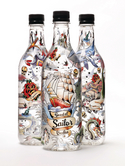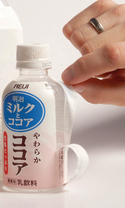The heat is on
8 September 2011There is no holding back sleeve-labels that are decorating, protecting, authenticating and promoting everything from soft drinks to luxury alcohol brands and perfumes. Joanne Hunter reports
The global sleeve-label market shows no signs of shrinking. The market continues to grow fast and at a much higher rate than other types of labels, with the trend particularly strong in the rapidly industrialising countries of South America, China and India. There seems to be no limit to its category penetration, whether as heat-shrink labels, stretch sleeves or ROSO (roll-on, shrink-on) shrink sleeves, according to the AWA Labelling and Product Decoration Markets Global Review 2010.
Sleeve-type label technology made up 12% of the worldwide label market in 2010, compared with glue-applied labels (41%) and pressure-sensitives (40%). By region, the world’s sleeve-label sales last year were Europe 38%, Asia-Pacific 32%, North America 25%, Africa 3% and South America 2%.
By format, heat-shrink sleeves dominated with 76% of the global market in 2010; stretch sleeves took 16%, and ROSO shrink sleeves had the remaining 8%.
Future growth for all sleeve-label formats is estimated to exceed 5% a year. Top end-users overall are foods and beverages. But sleeves are also up against growing competition from in-mould labelling (IML) for household chemicals, and from pressure-sensitive labels for cosmetics.
Technical advances are helping drive the sleeving sector. Thinner films, matt films, opaque films, coextruded films, and films with higher levels of shrinkage possible are opening up new opportunities in container decoration.
Promoters of sleeving believe the market development of PLA-based shrink sleeves to wrap PLA-based containers may answer the environmental concern about petroleum-based packaging. But they warn that this solution, as with every such proposal, must avoid problems at the recycling stage.
New design technology, as we shall see later, is helping to create a fast growing, worldwide community of sleeve-label converters, which is putting pressure on companies to maintain their margins and improve technical competence and product quality.
The community is meeting the challenge. In June this year in the Finat Label Awards Competition, with more entries for the sleeves category than ever before, the quality across the board was considered to be higher than it has ever been. The winning entry came from Stratus Packaging, of France, for a flexo sleeve for Soupe à l’oignon, judged to achieve impressively realistic-looking onions printed onto PVC film, 5-colour plus white with shrink to 50 micron.
Where then are the hotspots for market growth? According to Sleever International, one of the sector’s biggest players, luxury brands of perfumes and alcoholic drinks are using shrink sleeve technology more and more.
An eye-catching label with high quality printed special effects such as a gold or mirror finish can be turned around quickly, says Sleever spokesperson Sofiane Mameri. “In perfumes and alcohol, the bottle’s personality is just as significant as that of the contents. Materials, designer presentation, sophisticated ranges: nothing is left to chance in the quest to tease the senses and create the illusion [of luxury]. Limited editions and vintage versions also play a significant role in enabling timeless scents, for example, to constantly renew their image and acquire new devotees.”
Sleever is marrying technological development to market demand, explains Mameri.
“Some markets are looking to implement systematic solutions to guarantee the origin and non-opening of their products prior to usage. For this purpose Sleever has developed the UV-barrier Seelcap, that incorporates a protective barrier against ultraviolet rays to which new formulations, free of preservatives or rich in natural ingredients, are particularly sensitive.
“The solution is based on a brand-new high performance SI-OPS-TF/095-XB film, developed by Sleever Technologies. Besides its ability to maintain the integrity of complex-shaped products and its anti-dust and anti-static properties, it also offers a very high transparency index for enhanced presentation.”
Secondly, legislation in place since 2006 that makes Braille characters mandatory on all new pharmaceutical packaging has driven Sleever’s work on a marking technology that would guarantee the presence of the characters and their durability over time on the basis of various abrasion, durability and tracking tests.
Are there limitations for shrink sleeves; for example, do smaller or larger sizes of container pose any problems?
Absolutely not, says Mameri: “In terms of size you have no limits. Sleever International is decorating more and more big alcoholic product sizes (magnum, jeroboam) oxygen, gas and propane cylinders of 50-60 litres.”
Inventor of the concept in 1973, Sleever International has access to new materialtechnologies that are assisting the expanding use of shrinksleeves. At its R&D factory in southwest France, Sleever Technologies develops the physical-chemical and mechanical characteristics of thermoplastic polymer formulations.
The elasticity, shrink curve, softening point, transparency, thickness (+/- 3 micron) and mechanical resistance are adapted to create the performance level required.
“Among the most sought-after characteristics are surface aspect, barrier properties, special effects (holograms, soft touch), resistance qualities (shock, thermal effect, humidity) and recyclability. Over 50 exclusive formulations are currently available to create the Sleever range of solutions that can be adapted to any project.”
Mameri believes the ability to ever more creatively shape metal, glass and plastics is a key factor in the success of shrink sleeves. “Seeldrink, designed for liquid food goods in glass and PET bottles, meets the specific needs related to filling processes (aseptic, ultraclean, pasteurisation, etc), containers (shock resistance on the line, during transport) and high speed production lines. Notisleeve is another example, created for the pharmaceutical industry in the form of a sleeve which features a repositionable multipage leaflet label, an original, practical and competitive alternative to cartons. A highly competitive technique that does away with over-packaging, cost-effective for short runs and of irreproachable quality, sleeving benefits the entire logistics chain because of its effective protection.”
Lastly from Sleever, a new 3D-effect ‘to stimulate the consumers’ senses and thereby get closer to them’ has become a major component of the corporate brand marketing strategy, says Mameri.
Creative Toolkit
Creating shrink sleeves has been a longwinded, inefficient process for many years, but now EskoArtwork has changed life in the studio forever. The Studio Toolkit for Shrink Sleeves “remedies a very significant pain point for many package printers,” says Carsten Knudsen, EskoArtwork president and CEO. An ‘impressive’ ability to work with asymmetrical packaging and predict hue and colour shift based on stretching has won it a 2011 Printing Industries of America InterTech Technology Award.
The Toolkit creates 3D images that accurately predict the end result and can be used to approve designs faster and more cheaply than making and shipping mockups. Jobs can now take less than three hours, instead of up to 24 hours, says the developer.
The Studio Toolkit accounts for the specific shrinking properties of the chosen substrate. The pre-distortion can handle much more complex cases, leading to more creative designs on more sophisticated containers, says EskoArtwork. And the technology will open the door for less experienced printers to enter the sleeve label market, it adds.
CCL Decorative Sleeves attributes the success of shrink sleeves in drinks packaging to more than their, albeit outstanding, decorative functions. For example, in pack promotions, they are a means of grouping products together, including differently-shaped items, for multi-pack offers or the inclusion of free gifts. They can also serve as product protection through tamper evidence, which is critical for drink products. And use of anti-counterfeiting measures makes duplication more difficult and gives reassurance that the product is authentic.
In addition, specialist inks and finishes can create a light barrier for sensitive products, allowing a monolayer container to be chosen instead of one that has a light block layer, which helps in bottle recycling, it is argued. And with a sleeve to provide added strength and protection, the container itself can be lighter in weight.
Sleeves allow room for statutory information, barcodes and different languages without compromising the overall effect of the label design, says CCL; and sleeve technology negates the need for secondary packaging such as an outer carton. For this reason, GlaxoSmithKline Consumer Healthcare chose a CCL full body polystyrene label for Os-Cal calcium supplement in the USA. It replaced a wraparound pressure-sensitive label and is said to be saving significant levels of paper, CO2 emissions and energy annually.
Adding tiny perforations makes it easy to completely remove the sleeve and gives an uncontaminated bottle ready for recycling. This system is already widely used in the Japanese market, where the consumer has been educated to remove the printed part before putting a bottle into the recycling stream. This trend is likely to gather pace in European markets, thinks CCL.
A final environmental observation: renewable and 100% compostable alternatives are offering to replace petroleum-based films. As with any new application of bio-based material, however, where used there will have to be a suitable waste infrastructure to avoid disrupting existing systems.
What this exploration of the sleeving market makes clear is that there is more to it than meets the eye
Green sleeves
CCL Decorative Sleeves launched the ‘world’s first’ stackable square plastics beverage container for Ceethree’s iO, an energy drink by IO Drinks, of Sweden. The 25cl Cubis full-body sleeve is UV flexo printed in five colours on 50 micron OPS, with a matt lacquer effect and perforations for easy removal.
GlaxoSmithKline chose a CCL full-body polystyrene label for Os-Cal calcium supplement Os-Cal Perforations are widely used in the Japanese market for pack recycling purposes Perforations CCL sleeve decorates a ‘world’s first’ for IO Drinks CCL Galatea Spirits’ Good ol’ Sailor organic vodka in recyclable PET bottles features striking full body sleeves supplied by CCL Decorative Sleeves Galatea





